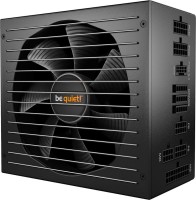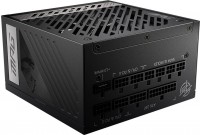How to choose a power supply for a computer?
We independently test the products and technologies that we recommend.

Actual Form Factors
First of all, you need to decide on the form factor of the power supply so that it fits into your PC case without any problems and connects to the motherboard.
ATX is the most common form factor for power supplies. The highest power is allocated (from 300 W to 1.5 kW) and, accordingly, large dimensions.
SFX and TFX are compact power supplies from 200 to 500 W. Models SFX outwardly resemble a smaller copy of the ATX, while TFX have an oblong shape. Due to their dimensions and mountings, they are used in minicomputers: office thin clients, home media centers, network storages and Steam Machine game consoles.
External power supplies - similar to power supplies for laptops, but are equipped with a power adapter-splitter for the motherboard and other PC components. Maximum power - 100 watts. Designed for the most compact PCs, in the case of which there was no place for an internal PSU.
Rated power and power per line
 |
It is important to consider that two models of power supplies for which the same nominal power is claimed, say, 500 W, in fact, can produce radically different power - from 300 to 600 W. There are several reasons for this.
Firstly, manufacturers of low-quality PSUs that come bundled with cheap computer cases can simply cheat by attaching a sticker from a 500-watt model to a 300-watt model. Whereas companies with a good reputation, on the contrary, often underestimate the claimed capacity of their PSUs compared to the real one. For example, the PSU is guaranteed to operate at a power of 500 W, but at the limit of its capabilities (peak power) it produces 600 W, although wear is significantly increased.
Secondly, the rated power of the PSU is the sum of the powers of the supply lines with different voltages: +3.3, +5 and +12 V. The +3.3 V line is practically not used in modern computers, and the +5 V line is used to power disk drives and low-speed fans, that is, it is not possible to load it with more than 100 W. The most important and powerful is the +12 V line, which powers the processor and graphics card (or several video cards). This line can be both common and divided into sub-lines (+12_1, +12_2, etc.). For different PSU models, the ratio of the power of the +12 V line to the rated power can differ significantly. A coefficient of 0.8 is considered a good indicator (for example, 400 W on the +12 V line with a nominal PSU power of 500 W), and a coefficient of 0.9 and higher (450 out of 500 W) is considered excellent.
80 Plus Certified
Another important characteristic of the power supply is efficiency - the percentage of electricity that is actually transferred to PC components, and does not turn into waste heat. For a simplified designation of the efficiency of power supplies, the 80 PLUS certification has been developed. Thus, a power supply unit with an efficiency of at least 82 percent at full load when powered by a 230 V household power supply is awarded an 80 PLUS certificate. In turn, models with an efficiency of 85 percent are certified 80 PLUS Bronze, 87 percent Silver, 89 percent Gold, 90 percent Platinum, and 94 percent just recently approved Titanium.
In addition, according to the 80 PLUS certificate, it is easiest to distinguish a high-quality PSU from a low-quality one. An unscrupulous PSU manufacturer, trying to save on everything possible, will certainly not spend money on official testing and certification. This means that having at least a minimum 80 PLUS certificate is, with a high probability, a guarantee of quality. However, there are many good PSUs without an 80 PLUS certificate (for example, the Aerocool VX and Chieftec iArena series) - they are quite reliable, they just do not reach the desired efficiency.
Cooling system
 |
Even the most energy-efficient Titanium-certified PSUs generate a significant amount of heat, which must be removed and dissipated in some way. Power supplies with completely passive cooling are very rare, as they are very expensive and limited in power to 500 watts. A little more common is a PSU with a fan switched off during idle time, however, hybrids are also not cheap. Massive on the market are power supplies with active cooling, but automatically adjustable depending on the load and temperature, the speed of the impeller. The fan diameter can vary from 80 to 135 mm - the larger, the quieter. A fluid dynamic bearing fan will stay quiet much longer than a regular sleeve fan, and additional lighting will brighten up the exterior of the PC.
Cables and connectors
 |
According to the method of attaching wires, power supplies are divided into three types: non-modular with tightly soldered cables, semi-modular with fixed main cables and removable additional ones, and, finally, modular, in which absolutely all wires can be disconnected. From the point of view of cable management, modular or at least semi-modular PSUs are better, as they allow you to get rid of wires that are unnecessary for your PC configuration. But in some compact computer cases, modular PSUs will not fit, because due to the ports for connecting wires, they are slightly longer than non-modular ones.
Mandatory cables include 20+4-pin for motherboard power and 4-pin (or 4+4) for CPU power. The reinforced power cable is required for the Intel LGA2011 and AMD FX-8000 processors (see How to choose a processor for your computer? article). You will also definitely need at least one SATA connector to power a hard drive or solid state drive (there are up to ten of them, combined two or three per cable). Already optional for case fans that are not powered directly from the motherboard, you will need large Molex connectors, and for some discrete sound cards, MiniMolex connectors, which were previously used for floppy drives.
A separate "bundle" comes with cables for powering video cards with 6 or 6 + 2-pin connectors. For entry-level video cards (GeForce GTX 750 and 750 Ti, Radeon R7 360), a power cable is not required at all, for mid-level ones (GTX 950, 960, 970, 1060, Radeon R7 370, RX 480) you need one 6 or 6 + 2-pin , and for the flagship ones (GTX 980, 980 Ti, 1070 and 1080, Radeon R9 380, 380X, 390 and 390X) - a pair of such connectors. Old and modern low-power power supplies may not have a connector for video cards at all, but you can use the Molex adapter that comes with some video cards in the kit or is sold separately.
Who actually manufactures power supplies?
On the shelves of stores there are power supplies of dozens of brands, but most of them themselves do not develop anything other than the design of the case, and even more so, they do not produce. Thus, power supplies of the popular Aerocool brand are built mainly on ready-made solutions from Andyson and HEC, while Chieftec, well-known to the east european buyer, use Sirtec and CWT circuitry. In principle, there is nothing shameful in this, it’s just worth considering that the same electronic “hardware” can be found in PSUs of different brands that differ in price by half. Not only for others, but also under their own brand, they produce power supplies from FSP and Seasonic companies known only. Finally, we recommend reading the article "Best choice: 5 power supplies for a computer".
Details about form factors, sockets and chipsets of motherboards.
It will handle any games on ultra settings at FullHD and 2K resolution.
Choosing the best processor for a cheap office, versatile multimedia and powerful gaming PC
Which processor is better: Intel or AMD? Pentium or Athlon? Core or FX?
Both lowering and increasing the voltage in the network can negatively affect household appliances.
Articles, reviews, useful tips
All materials

















